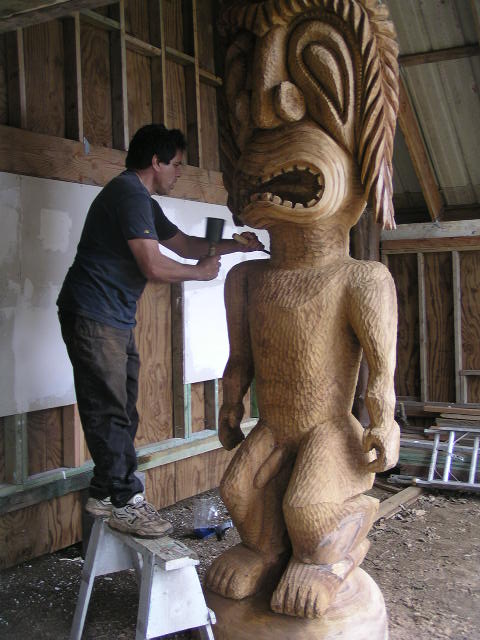Tiki culture is currently in vogue, characterized by vibrant hues, tropical atmospheres, and stylish wooden masks and totems. But beyond the surface level appeal, there is a rich history and symbolism behind the art of carved tiki. In this article, we will explore the artistry and symbolism of carved tiki and its significance in Polynesian culture.
On the other hand, a tiki with its hands on its face represents a symbol of protection. People often associate this tiki design with the idea of safeguarding oneself or others from harm or negative influences. Covering the face with hands is a way to protect against dangers or bad vibes. It serves as a reminder to prioritize self-care, emotional well-being, and the protection of loved ones.
These tiki designs have meanings from Polynesian mythology and culture. You can find them at tiki bars such as Don The Beachcomber or Trader Vic. They reflect the importance of being mindful, cautious, and protective in various aspects of life. Whether used as decorative pieces, tattoos, or as symbols in traditional ceremonies, tikis continue to hold significant cultural and spiritual value in Polynesian communities.
Symbolism in Carved Tiki
In Polynesian culture, people believe that the gods created tiki as the first man. Their mythology sees it as a symbol of protection and good luck, so it holds a special place. Tiki carvings show human qualities like strength, courage, and wisdom through bold features.

The patterns and symbols carved into tiki also hold great significance. For example, the spiral pattern represents the journey of life, while the fish hook symbolizes prosperity and abundance. These symbols add depth and meaning to the already intricate carvings, making them more than just decorative pieces.
Uses of Carved Tiki
In traditional Polynesian culture, people used carved tiki for various purposes, including religious ceremonies, piece of art, protection, and storytelling. Today, people still use them for these purposes, but they also popularize them as decorations in homes and businesses.

People use carved tiki totems in gardens and patios to add a tropical touch to their outdoor spaces. Wooden masks are also popular as wall hangings, bringing a unique and cultural element to any room.

In modern times, carved tiki have become popular decorative items, often used in tiki bars and tropical-themed parties. Showing respect and use these figures correctly are highly important because they are culturally important. Demonstrating respect and correctly utilizing these figures because of their cultural significance has been at the fore front.
Numerous artists and carvers dedicate themselves to preserving the traditional art of tiki carving. They create remarkable and intricate pieces that honor the cultural importance of carved tikis. Galleries and shops offer these pieces, and people often use them as decorative items in homes and businesses.
The Significance of Supporting Local Artisans
In recent times, there has been a noticeable surge in the production of tiki sculptures on a large scale. Manufacturers often use cheap materials to make these mass-produced tiki sculptures, compromising their overall quality and authenticity. Modern tiki sculptures lack the detailed designs found in traditional carvings that generations have passed down.
Mass-produced replicas often lose the meaning and cultural significance of traditional tiki carvings. Traditional tiki sculptures hold great importance in various cultures, representing gods, ancestors, or other spiritual entities. They are not just decorations, but they connect to the past and carry the customs and beliefs of their community.
To keep tiki art's essence and cultural importance, it's important to back local artists. These craftsmen create one-of-a-kind and authentic tiki sculptures using their talent and expertise. Craftsmen know the meaning and history of each carving. They make sure every piece they create follows the traditions and customs of tiki sculptures.
By supporting local artisans, we help preserve their unique art forms and cultural heritage. Their handmade tiki sculptures honor the skill and creativity passed down through generations. They also preserve the essence of tiki art and its cultural importance.

In Conclusion
Carved tiki is more than just a trendy decoration; it is a form of art that holds deep cultural significance. Each piece has detailed designs and meaningful symbols, bringing Polynesian culture to any space and telling a story. We can support local artists and their work to preserve the skill and meaning of carved tiki for future generations. By doing so, we can continue to enjoy and protect this art form.

Visit Tikimaster.com in Kailua, Oahu for a large selection of authentic carved tiki from all around Polynesia.












